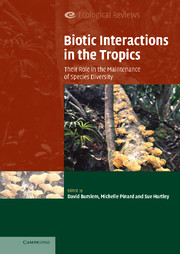Book contents
- Frontmatter
- Contents
- List of contributors
- Preface
- PART I Plant–plant interactions
- 1 Plant–plant interactions in tropical forests
- 2 Resource capture and use by tropical forest tree seedlings and their consequences for competition
- 3 Role of life-history trade-offs in the equalization and differentiation of tropical tree species
- 4 Neighbourhood effects on sapling growth and survival in a neotropical forest and the ecological-equivalence hypothesis
- 5 Ecological drift in niche-structured communities: neutral pattern does not imply neutral process
- PART II Plant–microbe interactions
- PART III Plant–animal interactions
- PART IV Biotic interactions in human-dominated landscapes
- Index
- References
3 - Role of life-history trade-offs in the equalization and differentiation of tropical tree species
Published online by Cambridge University Press: 25 August 2009
- Frontmatter
- Contents
- List of contributors
- Preface
- PART I Plant–plant interactions
- 1 Plant–plant interactions in tropical forests
- 2 Resource capture and use by tropical forest tree seedlings and their consequences for competition
- 3 Role of life-history trade-offs in the equalization and differentiation of tropical tree species
- 4 Neighbourhood effects on sapling growth and survival in a neotropical forest and the ecological-equivalence hypothesis
- 5 Ecological drift in niche-structured communities: neutral pattern does not imply neutral process
- PART II Plant–microbe interactions
- PART III Plant–animal interactions
- PART IV Biotic interactions in human-dominated landscapes
- Index
- References
Summary
Introduction
Early observations of the remarkable diversity in life history and morphology exhibited by tropical plants have strongly influenced our views on how these species coexist. Initially plants were classified according to size and life form, and subsequently into ecological species groups that recognized the importance of variation in light availability associated with the forest growth cycle (Richards 1952; Swaine & Whitmore 1988; Burslem & Swaine 2002). These ecological species groups reflect the existence of adaptive strategies that trees adopt during regeneration, and are the consequence of unavoidable trade-offs among suites of traits influencing growth, survival and fecundity.
In tropical forests, light availability has typically been identified as the primary limiting condition to growth. Adaptive strategies influencing the colonization of canopy openings and the capture or use of light are manifested as combinations of traits influencing dispersal, germination, seedling establishment, and allocation of resources to growth, storage and defence (van Steenis 1958; Budowski 1965; Whitmore 1975; Bazzaz & Pickett 1980; Coley et al. 1985; Kitajima 1994). This review addresses two issues: first, the extent to which individual trade-offs linking these traits can lead to the differentiation of tree species accounting for interspecific differences in the requirements for light and other resources; and second, the extent to which the action of multiple opposing trade-offs has a contrary effect of equalizing overall recruitment success so that no particular trait combination provides a recruitment advantage.
- Type
- Chapter
- Information
- Biotic Interactions in the TropicsTheir Role in the Maintenance of Species Diversity, pp. 65 - 88Publisher: Cambridge University PressPrint publication year: 2005
References
- 5
- Cited by



